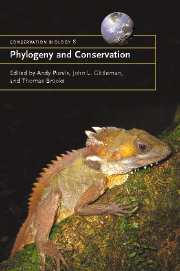Book contents
- Frontmatter
- Contents
- List of contributors
- 1 Phylogeny and conservation
- Part 1 Units and currencies
- Part 2 Inferring evolutionary processes
- Part 3 Effects of human processes
- 12 Conservation status and geographic distribution of avian evolutionary history
- 13 Correlates of extinction risk: phylogeny, biology, threat and scale
- 14 Mechanisms of extinction in birds: phylogeny, ecology and threats
- 15 Primate diversity patterns and their conservation in Amazonia
- 16 Predicting which species will become invasive: what's taxonomy got to do with it?
- Part 4 Prognosis
- Index
- References
14 - Mechanisms of extinction in birds: phylogeny, ecology and threats
Published online by Cambridge University Press: 04 December 2009
- Frontmatter
- Contents
- List of contributors
- 1 Phylogeny and conservation
- Part 1 Units and currencies
- Part 2 Inferring evolutionary processes
- Part 3 Effects of human processes
- 12 Conservation status and geographic distribution of avian evolutionary history
- 13 Correlates of extinction risk: phylogeny, biology, threat and scale
- 14 Mechanisms of extinction in birds: phylogeny, ecology and threats
- 15 Primate diversity patterns and their conservation in Amazonia
- 16 Predicting which species will become invasive: what's taxonomy got to do with it?
- Part 4 Prognosis
- Index
- References
Summary
INTRODUCTION
Effective conservation action and biodiversity management requires an understanding of the mechanisms that cause extinction (Caughley 1994). Theoretical treatments have suggested that these mechanisms are complex. They emphasise the interactions among factors such as the intrinsic biology of species, phylogeny, ecological relationships, environmental variation, human influences and chance catastrophes (see, for example, Diamond 1989; Pimm 1991; Lande 1998). Most conservation projects focus on protecting particular species or particular areas. This focus on the specific problems of particular species or areas can be successful in identifying the idiosyncratic extinction mechanisms operating at a local scale; however, much can also be learned by using comparative methods to synthesise information across taxa and regions. The major strength of formal comparative methods is that they allow us to test whether there are general processes that determine interspecific variation in vulnerability to extinction (Bennett & Owens 1997, 2002).
In this chapter we present a framework for investigating variation in extinction risk that emphasises the interactions between evolutionary history, ecological processes and contemporary threats. We will illustrate this framework by using our work on birds, which are arguably the best-studied vertebrate class and are therefore highly suitable for large-scale comparative analyses (Bennett & Owens 2002). We will discuss how the main extrinsic causes of extinction risk to birds, such as habitat loss and human persecution, have predictable outcomes due to differences between species in intrinsic biological attributes, such as life history and ecology.
- Type
- Chapter
- Information
- Phylogeny and Conservation , pp. 317 - 336Publisher: Cambridge University PressPrint publication year: 2005
References
- 6
- Cited by

